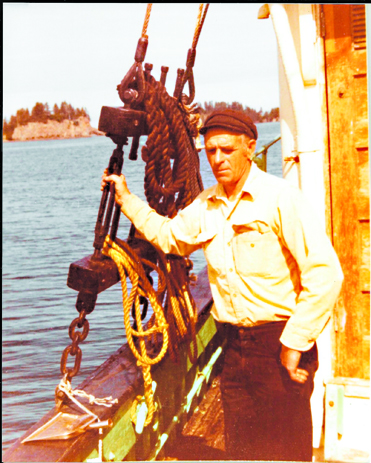Editor’s Note: This story has been edited to correct Bob Enea’s name.
A phone call from former crew member Jim Herbert informed David and Dennis Fry that the boat they fished on in the 1970s with their father was the Western Flyer — the vessel on which author John Steinbeck took the expedition chronicled in the book, “The Log from the Sea of Cortez.”
In an intriguing turn of the tide, Dennis Fry will speak at a symposium about the Western Flyer that will be live-streamed on YouTube on Saturday, April 16, from 8 a.m. to 4 p.m., Alaska Daylight Time.
To the Frys, the boat was the Gemini, David said. They knew a previous owner had changed the boat’s name from the Western Flyer, but they were unaware of the significance.
Clarence Fry, Dennis and David’s father, bought the boat from Whitney Fidalgo Cannery, which operated in Homer at the time.
“We commercial fished it,” David said. “We king crabbed, tanner crabbed, Dungeness, shrimp, and worked as a herring boat tender and a salmon tender. We’d take fish off of little boats and take it back to the cannery.”
During the six years that the Fry family owned the boat, they replaced all the moving parts, including the engine and steering. As the boat was built in 1937, some change was needed. However, Dennis kept the old boat pieces, eventually bringing them with him to Anderson, Calif., when he moved from Alaska.
Enter John Gregg, Michael Hemp and Bob Enea.
Annea and Hemp started searching for the Western Flyer in the mid-1980s. It turned out to be more than a 30-year hunt, Hemp said. About the same time they discovered the Western Flyer, a buyer swooped in and purchased the boat with plans to display it in a restaurant. Hemp and Enea engaged in a fight with the owner over the preservation of the boat.
Gregg, a geologist and businessman interested in purchasing the boat, started making offers to the owner. After a long period of no’s, Gregg received a yes, paying $1 million for the boat. The condition of the nearly 80-year-old boat is such that it requires another $2 million-$3 million to restore it to 1937 condition, money that Gregg is putting into it. Hemp is acting as the historian on the project.
“My role has to guide them through this and make sure that they don’t make any serious historical mistakes,” Hemp said.
The boat will become a floating classroom to teach kids about ocean conservation.
The plan is for the boat to start as an education program in Monterey, and eventually tour parts of the northwest, including Alaska.
“The irony is this boat helped extinct five major fisheries on the west coast. Now it is going to help save the ocean,” Hemp said.
While the restoration project won’t be complete for at least another year, the symposium will focus on various aspects of the Western Flyer’s history. Steinbeck boarded the Western Flyer for a voyage down to Mexico after publishing the “Grapes of Wrath,” Hemp said.
No other charter would take him, as many believed Steinbeck was a communist because of Grapes of Wrath’s focus on the plight of the workers.
“He spent six weeks working in the tide pools (in the day), drinking, partying and philosophizing at night,” Hemp said.
American marine biologist Ed Ricketts accompanied Steinbeck on the trip, and the result of Steinbeck’s trip is a book beloved by marine biologists today.
Many years later, the boat ended up in Alaska fisheries, where it served fishermen like the Frys.
Dennis will recount his experience on the boat he knew as the Gemini and show off the boat parts he saved for so long, which Hemp refers to as the “crown jewels” of the Western Flyer. Dennis can be seen on the live-stream at about 10:15 a.m.
For those unable to watch the symposium live, it will remain on YouTube as a video available for regular viewing as well.
Cannery Row, the non-profit organization in Monterey, Calif., that is putting on the symposium, plans on holding another symposium next year that will include a reunion of crews of the Western Flyer over its many years as a fishing boat. Hemp is looking to get in contact with anyone connected with the boat, especially in Alaska. Much of the Western Flyer’s history is yet to be completely pieced together, with the Frys as one of the more recently uncovered puzzle parts.
Anna Frost can be reached at anna.frost@homernews.com.
CANNERY ROW 2016 SYMPOSIUM
WHERE: Live on YouTube
WHEN: April 16, starting at 8 a.m., or watch anytime after the live-stream date,
at bit.ly/23tMx6F
Presenters:
Michael Hemp
Master of Ceremonies
Richard Astro
Keynote; Breaking Through
Steve Webster
An Addiction to the Sea of Cortez I’ve shared with Ed Ricketts, and stuff Steinbeck and Ricketts never saw.
Bill Gilly
To the Sea of Cortez in the Wake of the Western Flyer
Dennis Fry
Tales from an Alaska skipper of the ‘Western Flyer’—as the ‘Gemini’ and What I’ve Got To Show For it. Includes artifacts from the Western Flyer.
Lunch and Press Conference
Allen Petrich
A Brief History of West Coast Boatyards
Kevin Bailey
The Western Flyer and The Saga of Pacific Fisheries
Michael Hemp
EFR business contact cards recovered
Don Kohrs
Publication of the Revised Second Edition of Between Pacific Tides, 1948
John Gregg
Restoration of the Western Flyer: Western Flyer owner’s update
Susan Shillinglaw
He Aches Me Like a Missing Arm’: Steinbeck’s Ricketts and Ricketts’ Steinbeck


